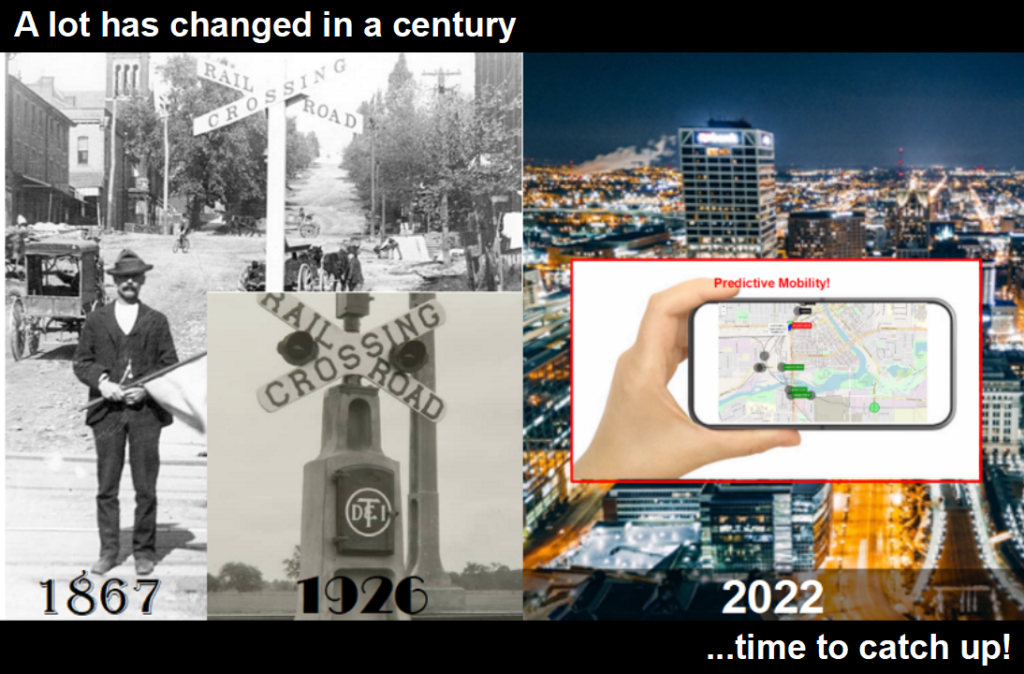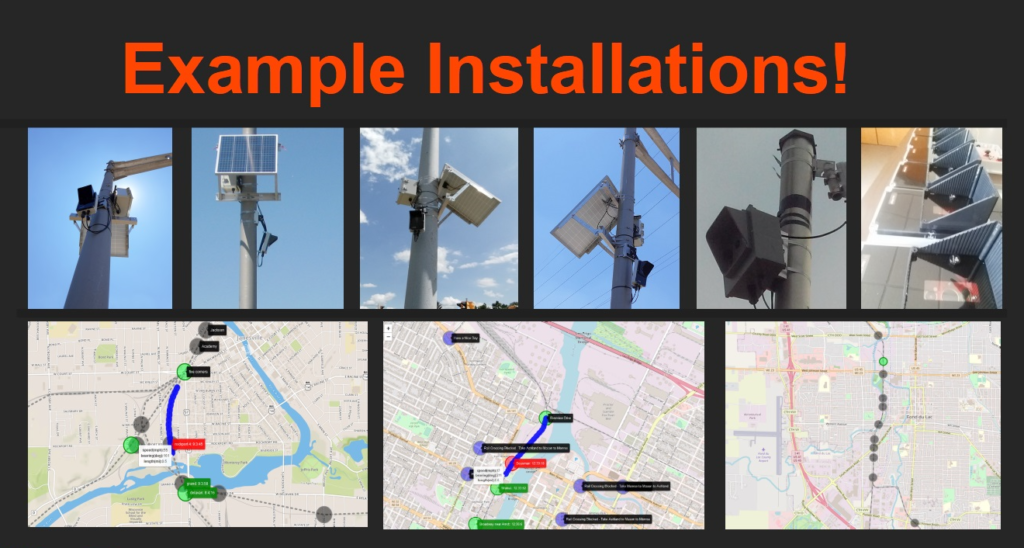Overview
Rail is still the most efficient and safe way to move freight. It is key to the supply chain in the US and one of the critical infrastructures that maintains the country. Cities grew up around rail lines and road traffic increased. Today some crossings pose a significant challenge to: Public Safety, Commerce, the Environment and People.
The busy CN line cuts right through the city of Fond du Lac, blocking crossings almost 3.5 hours per day at each of the 11 main line crossings. That is over 1000 hours each year per crossing. This results in roads blocked over 11,000 hours a year for the city. This does not include the time required to restore normal traffic flow after congestion has created a backed up queue of road vehicles.

In a typical day the longest time that the crossing is free is 45 minutes and it is typical for the crossings to be blocked for 30 minute. The average block time is about 6 minutes. The rail traffic is continuous on this line.

Rail Congestion in Fond du Lac
Rail congestion is a growing problem across the US. In this case study, we are specifically looking at the problem in the City of Fond du Lac. We performed the analysis following the Department of Transportation studies at the federal and state level, summarized on our site here.

Rail safety is essential for everyone – motorists, pedestrians, bicyclists, motorcyclists, buses and truck drivers. There are more than 4,030 public railroad crossings and 3,300 miles of active train tracks in the state of Wisconsin. The City of Fond du Lac has 11 crossings that have significant impact on mobility within the city.
- Every three hours a person or vehicle is hit by a train in the United States.
- As a motorist, you are 40 times as likely to die in a crash with a train, than in other motor vehicle crashes.
- In Wisconsin, every year 5-20 people are killed in rail crossing accidents.
Rail congestion has a $7 million impact on the city summarized below and explained in following paragraphs. This study includes only 5 of the 11 major crossings (Scott, Arndt, Forest, Division, Western)

Rail Congestion: An Exponentially Exploding Problem
Rail congestion is a growing problem in the USA. A study in Decatur, Illinois demonstrates that 97% of its people are chronically plagued with train-related delays. In 2017, the Chicago Metropolitan Agency for Planning found that motorists were delayed over 7,500 hours every weekday, costing them $58 million annually in lost productivity. A study in San Antonio, Texas demonstrated that this is a $1.5B problem, and the traditional bridge-or-tunnel solution would cost an astounding $2.5B. Congestion and emergency response delays at rail crossings have a significant national impact as described in a 2021 Senate report. see https://bit.ly/3InzlY5
7 Million vehicles travel over rail crossings in the City of Fond du Lac every year!
This is 21,100 vehicles per day or one vehicle every 6 seconds. Freight trains can be more than a mile long and block crossings an average of 12.5% of the time. The result is that freight trains delay 1 million vehicles per year waiting a total of 130,000 hours!
$256,000 in Excess Fuel Costs!
1 Million vehicles stalled at crossings burn only 0.083 gallons per minute. At the current $4.00 per gallon, this means that $256,000 is spent on fuel in a year waiting at crossings.
570 tons of Excess Carbon Launching into the Atmosphere per year!
Vehicles produce 8887 grams of carbon per gallon, translating into 570 tons of carbon per year. This EPA cost is $50 per ton of carbon, yielding a total expense of $29,000 per year.
$68,000 in Excess Operational Costs for Emergency Responders
Traditionally, emergency crews detour around rail crossings to avoid train delays. This typically means an extra 1-3 miles and 2-5 minutes of delay. The excess operational costs of these detours, at $3.25 per mile, means currently, emergency services are spending nearly $68,000 per year avoiding crossings in the City of Fond du Lac. Patients such as heart attack, stroke, traumatic injuries and crises like house fires, risk becoming more tragic as the delay increases.
$2.5 Million in Citizen Costs and $4.5 Million in Supply Chain Costs!
The Transportation Research Board studies the costs and delays of rail/highway accidents. They assign $16 per hour as the cost of delays to citizens and $108 per hour as the cost to logistics and other highway-based supply chain traffic (2009 cost figures). 30% of road vehicles are used in logistics and supply chain. This means that citizens are losing $2.3 million a year and logistics companies are losing $4.5 million in productivity costs per year in the City of Fond du Lac.
Rail Safety: Isn’t It About Time We Update A 100-year-old Solution?
Cross bucks were patented in 1867, while Red Signal Lights were first implemented in 1926. Shockingly, these still act as the current standard in identifying rail right-of-way. The only “early warning” is fixed yellow signs placed before the crossing. These signs provide ZERO information about current crossing status and do nothing to avert congestion and blocked emergency crews or notification of obstructions for oncoming trains. More than 50% of the 250,000 rail crossings in the US have automatic warning systems while 34.7% have flashing lights and gates. 60% of collisions occur at crossings with automatic warning systems. 94% of train-vehicle collisions can be attributed to driver behavior or poor judgment. People obtain and interpret information differently than before the advent of mobile apps, and tend to trust the information relayed on their phones, offering a way to help modify dangerous behavior.

Solutions to Rail Congestion
Bridge-or-tunnel and track relocation projects are the most traditionally effective way to address the safety and mobility issues caused by rail crossings. Bridge-or-tunnel solutions are prohibitively expensive, often costing between $5 million and $40 million. Complicated projects can exceed $100 million. Communities often don’t have resources necessary to undertake these construction projects.
Funding Improvements
The Federal Highway Administration’s (FHWA) Highway Safety Improvement Program (HSIP) Section 130 Program sets aside approximately $235 million in annual formula funds to states for safety projects at highway-rail crossings. Currently, at least 50 percent of a state’s apportionment must go towards adding protective safety devices at crossings, while the remaining 50 percent can be used for any hazard-elimination purpose. Better Utilizing Investments to Leverage Development (BUILD), Consolidated Rail Infrastructure and Safety Improvements (CRISI), and Infrastructure for Rebuilding America (INFRA) are competitive grant programs that fund infrastructure projects. There are $5B approved and appropriated to improve safety at rail crossings in the Build Better America Bill. Wisconsin has secured $505M in funding for transportation infrastructure improvements including safety at rail crossings. While these programs make meaningful investments in our nation’s infrastructure, they fund many types of projects and transportation needs, and due to heavy competition, problems often remain unaddressed.
A More Effective Solution
Predictive Mobility solves the problem of highway traffic congestion and blocked emergency vehicles at grade level rail crossings by providing advanced warning and the ability to avoid blocked crossings altogether.
see our predictive mobility page here: Predictive Mobility
see our predictive mobility video here: Predictive Mobility
How it works: Predictive Mobility places sensors on municipal property outside of railroad right of way. Sensor selection and processing are important to provide the most accurate measure of rail traffic. Some sensor arrangements can also sense highway traffic at the crossing and identify stalled vehicles, crossing guard failures and rail property trespassing. The train parameters are collected from these network sensors and combined in cloud-based software to generate a real-time predictive model of rail and highway traffic along with crossing open/block times and suggested alternate routes. The information can be provided as web/mobile applications for individual users, cloud API for Computer Aided Dispatch and Transportation Management Software, direct integration into traffic hardware or directly integrated to emerging autonomous vehicle systems. The advantages of Predictive Mobility are:
- Provides real-time information that can be more accurate and reliable than existing signage, gates and lights.
- Provides a future state of blocked crossings and alternate routes so that congestion and safety issues can be completely avoided.
- Software/Mobile application allows for improved messaging and a more tightly coupled interaction with traffic and actual driver behavior.
- The cost, time to implement, and resources required to secure funding and manage the project are a fraction of that of bridge-or-tunnel solutions.
*For the price of an electric bus – LinqThingz solution eliminates 46 times the carbon pollution.
*For the price of a typical bridge at one crossing – LinqThingz solution re-directs traffic at 5000 rail crossings.
Funding the Predictive Mobility approach with the budget of ONE bridge could provide immediate relief for ALL the top problem crossings described in the senate report cited above.

Summary
Rail congestion and delays have a surprisingly large impact on our communities. Traditional Bridge-or-tunnel solutions can be prohibitive. LinqThingz’ Predictive Mobility offers a modern, timely and cost effective solution to the problem of congestion that impacts: Public Safety, Commerce, the Environment and People.
